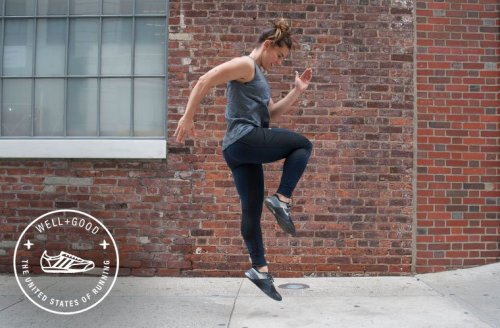When Jess Movold moved to New York, she explored the city by running it. “I started with a 5K here and a 10K there, and then one day, I ran to Brooklyn and realized I had covered 15 miles,” says the former high school sprinter who quickly became hooked on distance running. “My runs were mostly at an 8:30 to 9-minute mile pace, and to me that was great,” she says. “I wasn’t trying to get faster.”
Still, she managed to accomplish something pretty freaking unheard of, even among professional runners: She shaved more than 20 minutes off her personal best marathon time—clocking an impressive 3 hours and 14 minutes at the 2016 NYC Marathon, having crossed the finish line at 3:36 two years prior. How? “By running less and strength training more,” reveals Movold, 30, a NASM-certified personal trainer and coach for both the Mile High Run Club and The Fortitude Strength Club.
“I noticed that with a solid program of strength training and actually running less, I was getting stronger—and faster.”
Instead of running every day leading up to the 2016 race, she ran only two or three times a week, and she swapped her “mindless miles” for four to five heavy lifting sessions per week at The Fort.
“I noticed that with a solid program incorporating strength training and actually running less, I was getting stronger,” she says. “I was gaining more muscle and losing weight, and I was getting faster. It really showed when I was running on hills—and let me tell you, nothing is going to get you up those except muscle.”
“Now when things feel tough, I know how to tap into that extra strength to keep me there and stay consistent.”
Movold attributes her newfound speed not just to the physical strength she gained by picking up those heavy weights in the gym, but also to mental strength she worked on during those sessions. “You learn to push through those boundaries and get past thinking things are hard—because guess what? A marathon is hard! Mile 20 never feels easy,” she says. “But can you push through and tap into that next level of strength to carry you 6.2 more miles?”
Movold says that even though she felt strong and capable the year she ran a 3:36, she didn’t know the possibilities of the strength she had at the time. “I wouldn’t push myself past that uncomfortable feeling,” she says. “Now when things feel tough, I know how to tap into that extra strength to keep me there and stay consistent. I’m conditioned in a totally different, more efficient way—and I’ve learned to tolerate things that are difficult.”
Here are the 7 weightlifting moves Movold says helped her build muscle and cut her marathon time by 20 minutes.
1. Back squats
Do five sets of five reps
Using a straight barbell, set yourself up properly with an even grip on the bar outside your shoulders before unracking the weight. With your feet slightly wider than shoulder-width apart and nailed tightly to the floor, tuck the tailbone and drop down to the bottom of the squat in a parallel position. Keep the chest tall and the knees over the toes, then drive the weight back up, squeezing the glutes at the top. Start light and work on form and technique, then add weight once you’ve established your form and confidence. (Need to modify? Body-weight squats are just as effective, Movold says.)
How they make you faster: “This move builds full-body strength, which translates into stronger legs enabling faster hill climbs and the ability to blend speed with endurance,” says Movold. “So you’ll be able to run faster longer. Plus, squatting builds maximum strength, which improves endurance, resilience, and the ability to utilize fast-twitch muscle fibers and anaerobic capacity.”
2. Deadlifts on a straight bar
Do six sets of four reps
Stand tall an inch away from the bar. Brace your core as if you’re about to be punched in the stomach, and push your hips back to the wall behind you, keeping your knees directly above the ankles. Grab the bar just outside of the shins, and with the core braced, drive your feet into the floor and stand up, squeezing your glutes at the top. Maintain a neutral spine starting at the neck. The chin should be slightly tucked, and you should initiate the movement from the hip hinge, not the knees or lower back. Keep the weight low and build as your form progresses.
How they make you faster: “You’re working on full-body strength again, but this time with a heavy focus on abdominal stability and posterior chain,” says Movold. “This works on the hip hinge and hamstrings, carrying over into a faster turnover and more efficient stride.”
3. Reverse lunges
Do three sets of 12 reps on each leg
Standing with feet parallel and hips-width apart, hold a set of dumbbells in both hands at your sides, bracing your core tightly. Step back with one foot and drop down into a 90-degree lunge. Drive up from the lunge quickly, then switch legs.
How they make you faster: “Reverse lunges build strength and stability, which carry over when you’re in your single limb stance during your running stride,” says Movold. “This move supports ankle, knee, and hip stability while also demanding the core be engaged, and it builds quad strength.”

4. Front squats
Do four sets of six reps
Get under a barbell and keep it close to your chest, racked on your shoulders with your grip just outside shoulder width. Push the elbows forward and let the bar rest on the front part of your shoulders. From there, brace your core and hold it tight. Drive the knees toward the outside corner of your toes, and squat down until your hips become parallel to your knees. Drive the heels into the floor and stand up tall, squeezing the glutes at the top.
How they make you faster: “Of all the squat variations, the front squat is the most athletic and demands the most from your core strength,” Movold says.
5. Banded glute bridges
Do three sets of 20 reps
Place a mini band just above your knees, then lie on your back on the floor with the knees bent and feet shoulder-width apart. Keep the heels close to your glutes, brace your core, tuck your pelvis, and drive your hips up off the ground. Squeeze the glutes at the top and drive the knees out against the resistance of the mini band, then lower to the start position.
How they make you faster: “You’re targeting the glutes, especially the gluteus medius, for hip stability and increased explosiveness during your stride,” says Movold. “Plus, this move works the unilateral component for stability during a single-limb stance.”
6. Dumbbell floor presses
Do three sets of 10 reps
Lie on your back with your legs bent and the feet flat on the ground, keeping your heels close to your glutes. Holding a dumbbell in each hand, and bring your arms to a 45-degree angle from your ribcage. Lower your elbows to the ground, then drive the weights up to the sky with a full extension at the top. Use your breath to help drive the weights up, and exhale as you press, keeping the lower back nailed tightly to the floor and engaging your core strength.
How they make you faster: “Upper-body support is just as important when it comes to establishing strength and speed as a runner, especially when you’re tackling hills,” says Movold. “Shout-out to Coach Scott at Mile High Run Club, who loves to yell, ‘Arms! Arms! Arms!’ when you’re on those steep hills.”
7. Kettlebell swings
Do two sets of 50 reps
Stand with your feet slightly wider than shoulder-width apart, keeping your spine neutral, your weight in your heels, and your knees slightly bent. Holding a kettlebell with both hands, swing the weight between your legs, keeping it close to your pelvis as you hinge back so it doesn’t pull you forward. Snap the hips to drive the bell up so it’s parallel to the floor, squeezing your glutes as you stand tall. Keep your grip loose and make sure you’re driving the weight with your legs, not your arms.
How they make you faster: “You’re connecting the relationship between the quads, glutes, and core,” says Movold. Talk about teamwork!
Run smart! Here’s what you should eat and drink after a run, plus the running terms you need to know.
More from the United States of Running

Read the latest on Flipboard

Don't miss a single video on YouTube

More running tips from the pros
Sign up for the Well+Good SHOP Newsletter
Get exclusive deals on wellness, beauty, fitness, and food products that have been hand-picked by our editors.
Got it, you've been added to our email list.














